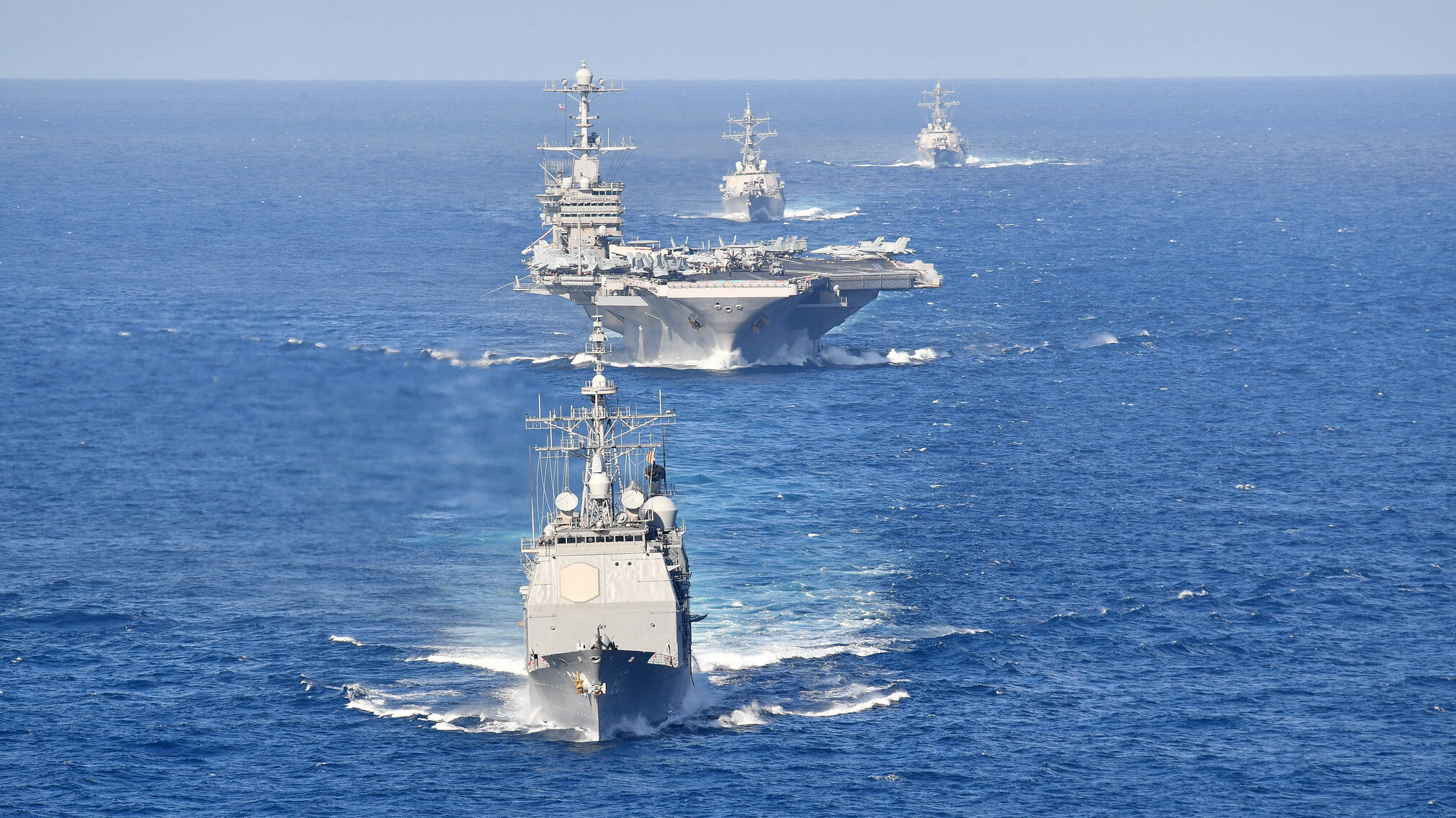
Harry S. Truman Carrier Strike Group in the Atlantic Ocean, April 2019. (U.S. Navy photo by Mass Communication Specialist 3rd Class Maxwell Higgins)
WASHINGTON — The Navy’s new budget request is seeking roughly $255 billion and with it the ability to buy nine battle force ships, including the second Columbia-class submarine, and decommission eight older, less useful vessels, including two Littoral Combat Ships with less than a decade of service.
The request includes approximately $202 billion for the Navy and $53 billion for the Marine Corps. The service’s shipbuilding account seeks one Columbia-class ballistic missile submarine, two Virginia-class fast attack submarines, two Arleigh Burke-class destroyers, two Constellation-class frigates, one John Lewis-class fleet oiler and one new submarine tender.
Notably, the service’s budget does not request any amphibious warships, an expected but bound-to-be controversial decision with lawmakers who recently received the joint Navy-Marine Corps study that outlined what the future fleet needs in terms of L-class vessels. Although the specific results of that study were classified, Marine Corps leadership has said publicly on multiple occasions that 31 amphibs is the minimum number.
Speaking to reporters ahead of the budget’s release, Navy Under Secretary Erik Raven was repeatedly why the administration has opted to take a “strategic pause” in purchasing amphibious ships and what message senior Navy leadership will send to Capitol Hill.
For more FY24 budget coverage, click here.
“We want to make sure that we are engaging with industry, we’re making smart choices about the right capabilities, and at the right price, and we’ll continue to work with the Hill and industry on those issues,” he said.
But Raven largely declined to answer more specific questions about the decision, such as how the situation differs from other Pentagon programs in which capabilities are often purchased and studied at the same time.
The new budget also begins to purchase eight rounds of the Navy’s new hypersonic weapon, developed in partnership with the Army, dubbed Conventional Prompt Strike. Rear Adm. John Gumbleton, the senior Navy officer charged directly with crafting the budget request, told reporters during the same roundtable that the budget also includes funding to begin work on integrating CPS onto Zumwalt-class destroyers.
In terms of ships on the list to be decommissioned, the Navy wants to retire three cruisers, three dock-landing ships and two Littoral Combat Ships. Most of those vessels are more than 30 years old, but the two LCS have not quite been in service for a decade.
Permission to retire any warship — particularly LCS — before the end of its service life is a fight the Navy has with the Hill every year, one that often ends with Congress including explicit provisions in the annual defense policy bill prohibiting the service from mothballing certain vessels.
Elsewhere, the new budget request includes $17.3 billion to procure 88 aircraft, including a mix of F-35 Joint Strike Fighters, KC-130Js, CH-53K King Stallions, MQ-4C Tritons, MQ-25A Stingrays and MQ-9A Reapers.
Notably, the Navy will not buy any new F/A-18E/F Super Hornets as it transitions to developing its next-generation fighter, ending a Boeing production line that has sustained naval aviation for more than 40 years. The company has said the production line is now set to wrap up in 2025 unless a deal is struck with India, in which the case line will remain active until 2027.
The FY24 budget request, if approved by Congress, will also complete the buys for the KC-130J, MQ-4C and MQ-9A programs.
On the research and development side, the service’s next-generation fighter aircraft F/A-XX is seeking $1.5 billion, the next-gen submarine SSN(X) requests $545 million and the next-generation destroyer program is asking for $187 million in funding. Project Overmatch, the service’s contribution to the Pentagon’s larger Joint All Domain Command and Control effort is seeking $192 million.
The budget does not include any specific requests that were shaped by the Marine Corps’ ongoing contributions to munitions being sent to Ukraine to fend off Russian invaders, according to Raven.
“Congress has been has really blazed the trail on how the department is assisting Ukraine,” he said. “They’ve provided us with not only presidential drawdown authority, but budgets to replenish equipment that’s provided to Ukraine.”
The new budget request does include funding though for four different munitions programs to enter five-year-long multiyear procurement contracts: Standard Missile, Naval Strike Missile, Long Range Anti-Ship Missile and the Advanced Medium Range Air-to-Air Missile. Of those programs, only Standard Missile has previously struck a multiyear procurement deal.
On the ship maintenance side, the new budget funds 37,000 full time workers in the four public shipyards, provides 75 ship maintenance periods and proposes investing $400 million industrial supplier development. The Navy’s plan to overhaul the public shipyards, known as the Shipyard Infrastructure Optimization Program, seeks $2.7 billion in funding, several hundred million dollars more than the $1.8 billion Congress enacted in FY23.
For the Marine Corps, the service is seeking investments to “accelerate” Force Design 2030 initiatives. Budget briefing slides shown to reporters in advance state those initiatives will request increased investments by $705 million, although the slides were not clear whether that number was an overall investment or relative to previously projected budgets.
The new budget also provides funding to support the Marine Corps’ three new Marine Littoral Regiments as well as five traditional infantry regiments.
“This is a strategy-driven budget,” Raven told reporters. “The budget reflects the nation’s priorities as detailed in US strategic guidance, and solidifies [Navy] Secretary [Carlos] Del Toro’s enduring priorities of maintaining maritime dominance, empowering warfighters and strengthening strategic partnerships.”






















